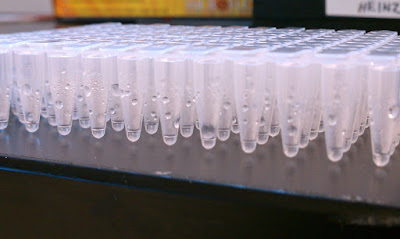Recently, the Young Lab’s ABI 7300 qPCR machine was calibrated. Steven asked me to run a plate and see how well the calibration worked. Ran a plate with C.gigas gDNA and Gigas 18s primers (SR ID: 156 and 157) that are known to amplify gDNA. Master mix calcs are here (top half of page). Cycling params were as follows:
- 95C – 10min
40 Cycles of:
- 95C – 15s
- 55C – 30s
- 72C – 30s
Melt curve.
Results:
Absolutely no amplification of any kind. However, I did use one of our conventional PCR plates and not one of the ABI “prism” plates. Additionally, when I removed the plate from the machine, the plate looked as though it had been vigorously shaken:

Will repeat this qPCR with a proper ABI “prism” plate.



